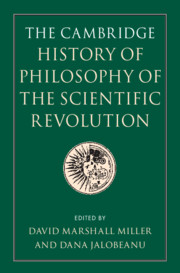Book contents
- The Cambridge History of Philosophy of the Scientific Revolution
- The Cambridge History of Philosophy of the Scientific Revolution
- Copyright page
- Contents
- Tables and Figures
- Contributors
- Preface
- Introduction The Disciplinary Revolutions of Early Modern Philosophy and Science
- Part I The Disciplines
- Part II Disciplinary Activities
- 8 The Art of Thinking
- 9 Astrology, Natural Magic, and the Scientific Revolution
- 10 Practitioners’ Knowledge
- 11 Medicine and the Science of the Living Body
- 12 Experimental Natural History
- 13 Celestial Physics
- 14 Applying Mathematics to Nature
- 15 Mathematical Innovation and Tradition: The Cartesian Common and the Leibnizian New Analyses
- 16 Mechanics in Newton’s Wake
- Part III Problems and Controversies
- Bibliography
- Index
9 - Astrology, Natural Magic, and the Scientific Revolution
from Part II - Disciplinary Activities
Published online by Cambridge University Press: 14 January 2022
- The Cambridge History of Philosophy of the Scientific Revolution
- The Cambridge History of Philosophy of the Scientific Revolution
- Copyright page
- Contents
- Tables and Figures
- Contributors
- Preface
- Introduction The Disciplinary Revolutions of Early Modern Philosophy and Science
- Part I The Disciplines
- Part II Disciplinary Activities
- 8 The Art of Thinking
- 9 Astrology, Natural Magic, and the Scientific Revolution
- 10 Practitioners’ Knowledge
- 11 Medicine and the Science of the Living Body
- 12 Experimental Natural History
- 13 Celestial Physics
- 14 Applying Mathematics to Nature
- 15 Mathematical Innovation and Tradition: The Cartesian Common and the Leibnizian New Analyses
- 16 Mechanics in Newton’s Wake
- Part III Problems and Controversies
- Bibliography
- Index
Summary
Historiography concerning the relationship (or non-relationship) between magic (or the “occult”) and “science” was dominated in the 1960s-1980s by the “Hermetic” thesis of Frances Yates and its critics (including Robert Westman and Brian Vickers). Vickers in particular argued that the “occult” and the “scientific” are separate “mentalities” or paradigms. This chapter considers an alternative view. By tracing the fortunes of the theory of radiative virtue advanced by the ninth-century Arabic philosopher al-Kindi, which began as a “theory of the magical arts” providing a physical basis for magical operations, we can see that some “magical” ideas connected with the astrological theory of “celestial virtues” influenced later natural philosophy. Al-Kindi’s suggestion that all causation in the elemental world was effected by means of rays was taken up in the medieval perspectiva tradition, and elaborated into a theory of astral magic by John Dee, but continued to provide a model for action at a distance in the mechanist theories of seventeenth-century natural philosophers, such as Kenelm Digby, Walter Charleton, and—ultimately—Isaac Newton, who believed that the corpuscles of all bodies acted at a distance by “certain Powers, Virtues, or Forces” in a similar way to the rays of light.
Keywords
- Type
- Chapter
- Information
- The Cambridge History of Philosophy of the Scientific Revolution , pp. 167 - 183Publisher: Cambridge University PressPrint publication year: 2022



